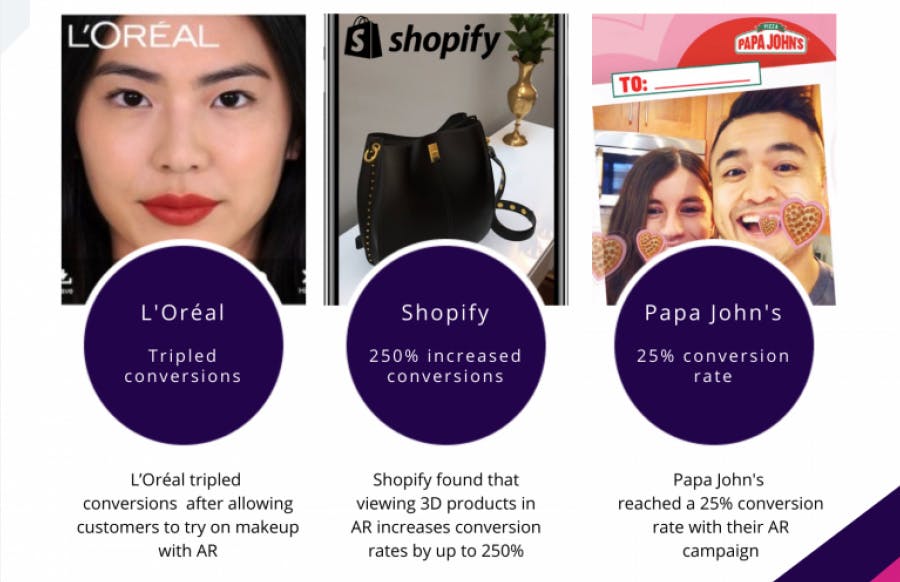Augmented Reality Advertising
Augmented reality is a powerful tool that consumers no longer just desire, but expect. Brands who have implemented AR in advertising, sales, education, product design, customer entertainment are now experiencing performance benefits and seeing increases in conversion rates. Through the use of AR, brands can offer their shoppers detailed product information in a more interesting and engaging way, allowing consumers to see more of the benefits that a product can provide.
Based on a Zappar report around the brain analysis of people using AR, brand awareness can increase by up to 70% through the use of augmented reality. No wonder brands are implementing AR campaigns like never before. In order to build a sense of loyalty and a lasting impression on their customers, brands have found that AR is able to do this in an effective and long-term way. AR ads are more successfully remembered by consumers because of their interactiveness and ability to be shared.
To define what we mean by AR advertising, these are paid media placements that allow consumers to activate their smartphone camera and superimpose branded animations in the real world. This is usually to promote or visualize a given advertiser’s products.
Advertising is one of the most lucrative AR subsectors, on pace to reach $1.41 billion this year and $8.02 billion by 2024, with a 54,43% compound annual growth rate.
With numbers like these, it’s no wonder that that ad revenue for AR has reached well over the billion-dollar mark. Brands are recognizing the value of this kind of advertising and taking advantage of its campaign performance.
Corona crisis
As is the case across the global economy, mobile AR sectors will be impacted unevenly by ongoing global lockdowns. Given that software mostly fares well in shelter-in-place life, the impact on mobile AR will be mostly positive.
For example, quarantine-friendly consumer AR like social lenses are trending up; and social distancing compels enterprise remote-AR support. These factors will boost near-term adoption while exposing the technology… which in-turn supports its longer-term sustained adoption.
Conversion rates
Brand advertisers are also attracted to AR’s business case that continues to be validated in ROI metrics and one of the best metrics is conversion rate. Higher conversion rates indicate that consumers are satisfied with a large part of the marketing strategy and content that is being presented to them. The main reason why AR advertisements achieve high conversion rates is immersive product try-on that encourages informed purchases. Although every ‘high’ conversion rate is unique to each industry, a twenty to eighty percent, which was measured conversion rate on AR ads, is over ten times higher than the average conversion rate across all industries on the search network.
As mentioned, campaigns such as L’Oréal’s AR showcases have seen increased conversion rates, and have continued to work with brands such as Poplar in order to successfully create even more. Plus, brands like the pizza chain Papa Johns have joined in and gained a 25% conversion rate with their AR campaigns.

Final Words
The proof of AR is in its conversions. While many brands are still using AR to engage their followers and increase brand awareness, the benefits of AR as a conversion tool are only increasing.
As more and more brands continue to report on successful conversion rates, we can expect the adoption of AR to move away from simple engagement into an active channel in the marketer’s toolkit to drive higher conversions and sales.
Related articles
AR vs MR - Unraveling the World of Augmented and Mixed Reality
This blog post provides an in-depth comparison between Augmented Reality (AR) and Mixed Reality (MR), two groundbreaking technologies that have transformed our interaction with the digital and physical worlds. The article discusses their applications, challenges, and current state of adoption.
VR Hand Tracking: More Immersive and Accessible Than Ever
Hand tracking technology in virtual reality has become a game changer, providing a more natural and immersive way of interacting with virtual objects. The number of VR devices supporting hand tracking has increased by 119% from 2021 to 2022, and the average price of VR headsets that support hand tracking has dropped by 93%. This trend is set to continue, making hand tracking in VR more accessible and affordable for everyone.